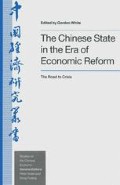Abstract
After the Beijing massacre of 4 June 1989, the Chinese state faces a political crisis of a scale and depth unprecedented since the Communist Party came to power in 1949. Though the Communist regime has faced both economic crisis (notably the aftermath of the Great Leap Forward) and political instability (notably during the Hundred Flowers Movement and the Cultural Revolution), it has managed previously to meet the challenge and take action to restore some degree of political ‘normality’, and refurbish the party’s injured prestige. In the late 1980s, however, the Party faces a dual crisis: an economic impasse which has developed as the reform programme ran into increasing difficulties from 1985 onwards, and a political crisis, reflected and intensified by the indiscriminate state violence in Beijing on June 4. This leaves a regime led by ancient revolutionaries without ideological clothes, its legitimacy shredded and lacking a credible programme for solving the nation’s deep economic problems. It is indeed paradoxical that a market-orientated economic reform programme — which was adopted in part to recoup the prestige and legitimacy of the Communist Party-state that had been badly shaken by the Cultural Revolution — should culminate in a set of events further intensifying the crisis of the Chinese state. How could it be that the reforming regime of Deng Xiaoping — which had achieved much in raising popular living standards, energising the economy, allowing greater cultural and intellectual freedom, opening doors to the external world and even achieving marginally greater political freedom and opportunities — had committed an act of state violence unprecedented in the history of the People’s Republic.
Access this chapter
Tax calculation will be finalised at checkout
Purchases are for personal use only
Preview
Unable to display preview. Download preview PDF.
Notes
For further analysis of the notion of the ‘developmental state’ in the East Asian context, see my (ed.) Developmental States in East Asia (London, Macmillan, 1988); for a discussion of different forms of developmental state, see
my ‘Developmental States and Socialist Industrialisation in the Third World’, Journal of Development Studies, vol. 21, no. 1 (1984), pp. 97–120
For preliminary analysis of the June 4 massacre, see Amnesty International, People’s Republic of China: Preliminary Findings on Killings of Unarmed Civilians, Arbitrary Arrests and Summary Executions since 3 June 1989 (London, August 14 1989)
Michael Fathers and Andrew Higgins, Tiananmen: The Rape of Peking, (The Independent, London, 1989)
For sophisticated analyses of central-local relations both before and during the reform decade, see Christine P. W. Wong, ‘The problematic role of the local sector in post-Mao reforms’, paper for a conference on ‘China in a New Era: Continuity and Change’, Manila, 1987; and
Jonathan Unger, ‘The struggle to dictate China’s administration: the conflict of branches vs. areas vs. reform’, mimeo, Contemporary China Centre, Australian National University, Canberra, 1987
‘Economist examines problems of ‘grim’ economic situation’, Xinhua [New China News Agency], in English, 6 Sept. 1989, in BBC, Summary of World Broadcasts: Fareast [SWB] 0556 (8 Sept. 1989)
‘Veteran cadres expelled from Party, companies dissolved’, Xinhua, in Chinese, 11 Sept. 1989, in SWB 0561, 14 Sept. 1989.
For an analysis of the Taiwan case, see Robert Wade, ‘State intervention and ‘outward-looking’ development: neo-classical theory and Taiwanese practice’, in White, ed., Developmental States in East Asia, 1988, pp. 30–67, and
A. Amsden, ‘Taiwan’s economic history: a case of Etatisme and a challenge to dependency theory’, Modern China, 5: 3, 1979, pp. 341–80
For more contributions to this debate, see Du Ruji, ‘Reflections on new authoritarianism’, Zhengzhixue Yanjiu [Political Studies Research], 3:1989, pp. 21–25
Rong Jian, ‘Is new authoritarianism feasible in China?’, Shijie Jingji Daobao [World Economic Herald], Shanghai, 16 Jan. 1989
Hao Wang, ‘A theory of transitional democratic authoritarianism’, Political Studies Research, 3:1989, pp. 16–20
Editor information
Editors and Affiliations
Copyright information
© 1991 Gordon White
About this chapter
Cite this chapter
White, G. (1991). The Road to Crisis: The Chinese State in the Era of Economic Reform. In: White, G. (eds) The Chinese State in the Era of Economic Reform. Studies on the Chinese Economy. Palgrave Macmillan, London. https://doi.org/10.1007/978-1-349-11939-4_1
Download citation
DOI: https://doi.org/10.1007/978-1-349-11939-4_1
Publisher Name: Palgrave Macmillan, London
Print ISBN: 978-1-349-11941-7
Online ISBN: 978-1-349-11939-4
eBook Packages: Palgrave Economics & Finance CollectionEconomics and Finance (R0)

